100 years following the first extensive excavations of the famous Mississippian Indian site, questions remain…
By Chris Bryant
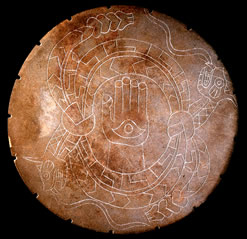
Twenty-eight flat-topped earthen mounds, covered in grass, rise from the ground at the outskirts of Moundville, the small Alabama town that owes its name to their presence. The area’s tranquility belies the bustling economic and ceremonial center this place, at one time the largest city north of Mexico, once was.
It’s been approximately 800 years since the first of the mounds were constructed by the Mississippian Indians, and 100 years since Clarence Moore, the first researcher to conduct extensive excavations at the site, began his investigations. Although more than 1 million artifacts and some 3,000 sets of human remains have been recovered from the site, many of Moundville’s secrets remain hidden, concealed by the passage of time and obscured by layers of soil.
What led to the site’s initial development? What led, more than two and one-half centuries later, to its seemingly sudden fall? Why did this former economic and ceremonial center transform into a necropolis, and why did it later fail – even as a “city of the dead”?
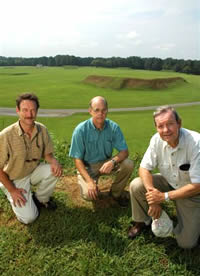
Dr. Vernon James Knight, professor of anthropology at UA, is one of the world’s leading experts on Moundville, having invested the largest portion of his distinguished 30-year career researching the mounds. Through extensive study, researchers now know much about the former residents’ health, their sustenance, and their daily life. Other things remain a mystery.
“Two things that are left hanging are how did it get started in the first place, and what caused the ultimate collapse?” Knight said. “We really haven’t tackled that as seriously as we have other questions.”
Dr. John Blitz, assistant professor of anthropology at UA, initiated the Early Moundville Archaeological Project in 2004, to try and answer the first of those questions. Invigorated by an annual field school, in which UA anthropology students learn basic excavation techniques, EMAP’s goal is to learn more about Moundville’s origin and early development.
“The beginning and endings of things are always difficult in archaeology, and they are also the most interesting,” Blitz said. Moundville follows suit. “Families who were formerly independent came together to form a larger group with a permanent leader,” Blitz said. “It was a new way of life. We don’t quite understand how that happened.”
Clues, however, await discovery, Blitz said. “One of the things we can do is try to find house remains and artifacts from just before and just after Moundville was formed and compare them for any evidence of economic competition among families.” Understanding relationships among families can provide insight as to how a family’s status might have translated into political leadership, Blitz said.
Artifacts were removed from Mound X, a low bump near the park’s roadway, during the Blitz-led field school. “It turns out, it is one of the oldest, if not the oldest, mound that we know of, and it existed prior to the bigger mounds forming around the park.” Analysis of the removed artifacts is under way.
Searching for House Remains
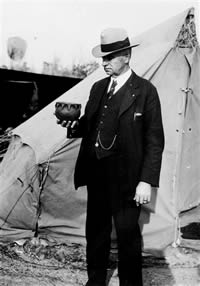
Although little evidence of the structures remain, underground soil stains can provide researchers with insight into the buildings’ outlines, and potential discoveries, such as nearby food remains or bits of discarded tools, can offer additional clues of relationships among families.
“If we find evidence of feasting,” Blitz said, “where one family hosted or supported others – that raised their prestige and influence and may have been one step toward creating more permanent leaders.”
Knight, who, like Blitz, earned his undergraduate degree from UA and teaches within the College of Arts and Sciences, is seemingly irrevocably linked with Moundville. “The first trowel I ever stuck in the ground was at Moundville,” he said. “That sort of spoils you a little bit. I tell my students that they’re completely spoiled. Having done their first dig at Moundville, everything is downhill from there.”
The mounds – the largest of which rises some 58.5 feet high and covers some 1.75 acres – began as small elevations that would have been a stretch to call a hill, Knight said.
“They were constantly rebuilt over a period of years,” Knight said. “After being used for a century or so, that can build up. What starts out to be a mound only about knee high can end up being a towering thing if it’s added to over a long period of time.” Some Native Americans who live in Oklahoma still construct small mounds, only two to three feet in height, for ceremonial uses, Knight said.
Moundville Misconceptions
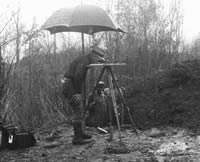
The general public has many misconceptions about Moundville, including an inaccurate belief that the mounds originated as massive monuments, designed to elevate the nobles’ residences and to signify their power and prestige, Knight said. Others falsely, but commonly, believe the mounds were constructed to hold the dead.
“What you see now is just the final version. At some point, they did decide to monumentalize them and bring them up vertically quite a bit, but not initially. Initially, typically, they are pretty low and fairly inauspicious.”
Multiple structures, built from wooden poles and thatch and packed closely together, once sat atop individual mounds. “A lot of them were residences,” Knight said. “Some were probably more council houses than residences.”
Moundville’s former residents likely numbered around 1,000 in the late 1300s and early 1400s, Knight said. Villages sprinkled along the Black Warrior River Valley brought the area’s total population to roughly 10,000, researchers estimate. “When Moundville was at its height, it was really the biggest thing going in the eastern U.S.,” Knight said. While most Mississippian towns lasted a century or less, Moundville lasted for some 250 years, from its beginnings in the early 1200s to its collapse around 1450.
The community developed at a time when the people were shifting emphasis from the hunter-and-gatherer way of life to more of an agricultural emphasis, Knight said. At Moundville, that emphasis was corn.
“What we see at Moundville, was sort of a coalescence of people coming together – for mutual ceremony, mutual defense – forming a new society. We had not only local people changing their lifestyles to come enter this new arrangement, but also people moving in from other places.
“It looks like an event,” Knight said, “as if somebody snapped their fingers and said let’s do this, and planned the whole thing. It has that character rather than some sort of drawn out process that happened piecemeal.”
That event may have been linked to the “nasty warfare” that was under way at the time, Knight said. A three-mile-long protective wall surrounded three sides of the city, with the fourth side garnering its protection from the Black Warrior River, flowing some 200 feet from the park’s nearest mound. “A lot of energy went into building that fortification wall around the city by cutting down over 30,000 pine trees at one time and planting those into the ground.” Every 30 meters around the wall, fighting platforms were constructed. “It was a huge effort at defending that place and taking that flat plaza in the middle (large enough to contain about 40 football fields) and artificially leveling it – by clipping off the high spots and filling in the low spots.”
The fortification wall was removed, about a century later, apparently having fulfilled its protective purpose, Knight said. “It worked,” the UA archaeologist said. “Other Mississippian towns were burned repeatedly … not Moundville.”
In addition to being ahead of their counterparts defensively, Knight said the Mississippians who lived at Moundville were more politically advanced than their contemporaries and had a level of art sophistication, including an interest and ability to depict three-dimensional details – such as the muscles of the human anatomy – not seen elsewhere in North America.
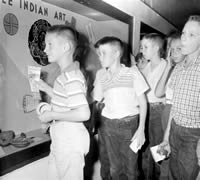
Moundville, which most Alabamians may associate with grade school field trips, is more widely known internationally than by the residents who share its state borders. Eleven doctoral dissertations, completed by students outside of UA, have focused on Moundville. Three separate archaeology field schools, led by researchers from the University of North Carolina, University of Michigan and the University of Oklahoma, respectively, all regularly set up camp at the site. Archaeology students all over the world study Moundville, Knight said, with an emphasis similar to what’s placed upon the Stonehenge ruins in England and the Pyramids of Egypt.
One Alabamian who apparently had no difficulties seizing upon the significance of Moundville was the late Walter B. Jones. An Alabama native and UA graduate who earned his doctorate at Johns Hopkins, Jones returned to his alma mater in 1924 and accepted a position as assistant to Eugene Allen Smith, a UA professor and the state geologist.
Dr. Doug Jones, UA professor emeritus of geology, said he well remembers his father’s love of Moundville, which seemed to border on obsession. It’s a love that was passed from father to son.
“My father was quite a raconteur, and he was always talking about Moundville,” Doug Jones, 75, recalled. “Every Sunday afternoon we would go to Moundville for him to talk with the staff people there about this, that and the other.”
Vandals, Erosion Hits Mounds
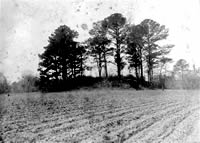
When looking today at the well-kept 320-acre park operated by UA, it is difficult to imagine the site as Jones remembers it as a child, when the land was owned by multiple private land owners.
“Dad realized the place was eroding,” said Jones. “I remember as a kid going down there and looking at some of the mounds that had trees on them 75 feet high. The forest was encroaching.” Large portions of the site were being farmed by multiple families. “I can remember seeing six-foot-tall corn stalks on top of the big flat mounds,” Jones said. “Anything they could get a team of mules up there to plow, they farmed. Well, that was plenty tough on the mounds.”
A greater concern to Jones’ father was the curiosity seekers and the elements which were both aggressively tampering with the site. “Dad’s real concern was the place was being vandalized. People were coming in there and digging up pots and burials. And erosion, particularly from the river side, was getting pretty bad.”
Jones said he grew up hearing people tell how his dad had mortgaged his family’s own house, twice, in order to raise funds to purchase various tracts of land surrounding the site. He recently confirmed the stories, discovering concrete evidence among his father’s personal papers.
His dad’s willingness to borrow money in combination with donations by regents of the Alabama Museum of Natural History were instrumental in obtaining and restoring the property, as was Walter Jones’ successful effort in landing a camp of workers from President Franklin Roosevelt’s Civilian Conservation Corps program.
Over a five-year period, CCC workers built a series of erosion control dams near the site and, under the direction of the elder Jones, his wife Hazel, and James T. DeJarnette began some excavations of the mounds and nearby burial sites. They also graded the land, planted trees and sowed grass and constructed a museum to house some of the artifacts.
Doug Jones, who served UA in various capacities including as dean of the College of Arts and Sciences and director of its Museum of Natural History, said his dad’s Moundville passion was driven by a desire not to punish the former inhabitants, twice. “His concern was ‘we took away everything the Indians had. The least we can do is preserve this monument in their memory. ’”
Mounds Take Back Seat to Giant Cemeteries
Despite the neglect, the vandalism and Moore’s 1905 and 1906 excavations, when techniques were understandably crude by today’s comparison, Knight said the mounds themselves were well preserved when he returned to UA to teach and re-launch the Moundville field school.
“No one had ever worked in the mounds except for Clarence Moore,” Knight said. “Unlike all the big Mississippian centers where early archaeologists headed straight for the mounds – because they thought that was where the most interesting things would be – all of the 1930s work in Moundville avoided the mounds in favor of doing a lot of work in the flat area around them. There was a sense in the 1930s that Clarence Moore had probably gotten everything there was to get from the mounds. The mounds had architecture on them, but that wasn’t as interesting as the giant cemeteries all over the site, with grave goods and that sort of thing. Clarence Moore had gotten into the cemeteries, but he hadn’t really done as much as people thought.
“It was sort of a backward situation where we knew a lot about everything but the mounds,” Knight said. “That seemed to me to be sort of a glaring gap about what we knew about the place and one you could fill in without excavating the mounds, per se. You can dig a little narrow trench in the flank of most of them and get everything you needed to know about when they were built, their construction and what activities were carried out on them, just by the trash that was thrown out on the side.”
The tops of two distinct mounds, known as Q and E, were stripped off by a Knight-led team to study the architecture. “We’re saving the vast majority of what’s out there for future investigation,” Knight said.
One answer awaiting future discovery is what led to Moundville’s abandonment.
Archaeological evidence shows a point where fewer people were working on the mounds, and surrounding towns began gaining importance, no longer deferring to mighty Moundville. “There are signs of local political trouble,” Knight said. At one point, the former bustling city became only a great cemetery – albeit an important stop, the Mississippians believed, for the dead to make to ensure a successful journey into the afterlife. Later, even the caretakers of the giant burial ground abandoned the site.
In time, researchers say, the well-documented details from 20th century excavations, combined with today’s efforts and the future research of new generations of archaeologists will answer more of Moundville’s mysteries – and raise new ones.
“We can draw on this 100 years of research which has given us an extraordinary picture of what life was like at Moundville,” Blitz said. “And then we can sharpen our questions even more, building on that base of knowledge.”
Further Reading